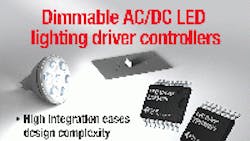Phase-dimmable LED lighting drivers support high-performance dimming
At the Strategies in Light Europe conference, Texas Instruments Inc. (TI) introduced two highly integrated, phase-dimmable ac-dc LED lighting drivers, LM3448 and TPS92070, for use in solid state lighting for residential, architectural, commercial and industrial applications, such as retrofit bulbs, LED ballasts, downlights, spot lights, and other luminaires.
The National LM3448 adaptive, constant-off time ac-dc constant current LED regulator integrates a 600-V MOSFET and is optimized for 2 to 8 W dimmable LED lighting drivers. The TPS92070 flyback ac-dc constant current LED driver controller is optimized for 6 to 20 W dimmable LED lighting drivers. Both products feature thermal shutdown, VCC under-voltage lockout, cycle-by-cycle peak current limit, and LED open protection.
Key features and benefits of the LM3448:
- Designed for integrated LED lamp form factors that require low component count, high-performance, dimmable LED drivers.
- Includes a phase angle dimming decoder compatible with leading-edge TRIAC and trailing-edge electronic dimmers, allowing full-range LED dimming.
- Integrated 600-V avalanche-protected, high-voltage, and low Rds(on) MOSFET reduces design complexity while improving LED driver efficiency.
- Can be used in both isolated and non-isolated solutions based on the buck, flyback or buck-boost topology, using either active or passive (valley-fill) power factor correction (PFC) circuits.
- Advanced TRIAC dimmer management circuitry accurately decodes dimmer conduction angles and produces a good exponential LED current profile to provide efficient dimming performance and uniform LED light output.
- Optimized for valley switching and tight LED current regulation (less than 5% driver-to-driver accuracy) during deep dimming.
- Innovative secondary side feedback eliminates optocouplers and error amplifiers in isolated designs, reducing size and cost while enhancing safety and reliability.
- Can be used in both isolated and non-isolated solutions based on the flyback topology and gives designers the flexibility to optimize their external component selection based on size, cost, and regulatory requirements.
- Detects the presence of a TRIAC and disables the external PFC function (either valley-fill or active) for improved dimming performance.
